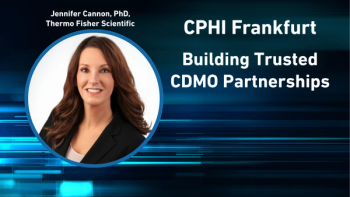
- Pharmaceutical Technology-01-02-2007
- Volume 31
- Issue 1
New Strategies for the CRO–Sponsor Relationship
The evolving contract research organization–sponsor relationship has initiated a state of transition for contract analytical laboratories.
For years, we've heard that the low-hanging fruit of the pharmaceutical world has been picked. Companies now are challenged to develop complex new drug products (complete with intricate formulation and manufacturing processes) quickly and efficiently. Drug developers balance on a knife's edge, trying to formulate innovative new compounds quickly that will survive late-stage clinical trials while identifying safety, formulation, and production pitfalls early.
To achieve this balance, companies both large and small are turning to sources such as contract laboratories with hopes that their technical expertise can help. As such, big changes in business strategies and technical offerings are happening at contract analytical laboratories. Five years ago, for example, contract research organizations (CROs) were seen as little more than an extra set of hands to help sponsors handle overflow jobs.
Photo credits (clockwise from left): Norac Pharma, Bioconvergence, Norac Pharma, Lancaster Laboratories
"When I outsourced analytical work years ago, I was more or less interested in having a laboratory provide analytical results," says Peter Nelson, director of analytical services at Micron Technologies, Inc. (Exton, PA). "I just needed a lab that had a particular piece of equipment. I knew I needed a test. I knew what the data meant. I just wanted an answer."
Now, partnerships with CROs are becoming more strategic. "We have become secondary drug development entities. We're almost like an external development department. It's a move to seeing CROs as partners, even though they are external companies," notes Bob Lima, PhD, vice-president of pharmaceutical sciences at Cyanta Drug Development Services (Maryland Heights, MO).
Robert M. Reagan, Lancaster Laboratories' (Lancaster, PA) senior director of pharmaceutical business development, agrees. "We have become the technical experts for industry. Clients look to us to provide technical expertise as though we are a true extension of their in-house laboratory. Now, we are solution providers."
Ten questions to ask a prospective contract laboratory
This new relationship has initiated a state of transition for CROs. "More and more, customers are saying, 'You've provided the answer, but what does that mean to my product? How will it affect my product performance? Will that help me predict product performance downstream?'" explains Nelson. As a result, CROs are serving clients in new ways as partners by offering development expertise as well as additional services.
Using GMP lite
In an effort to be first to market, companies are shortening the drug development timeline by running numerous trials in parallel and combining Phase I and II studies. Unfortunately, the accelerated study path could generate less development data about formulations than companies previously produced.
Notes Lima, "Instead of having three years worth of data on their formulation and a lot more optimization of the components in the formulation, companies have a number of prototypes and the clinic is still making the first-pass decision about which one will be done long term." As a result, companies don't spend as much time scaling up processes, the analytical methods aren't as solid, and knowledge about the impurities and degradants is weaker than it used to be.
Company Web sites
CROs are becoming an important piece of the speed-to-market puzzle by filling in the manufacturing blanks and offering more hand-holding analytical support to clients as they move through the drug development process. For example, CROs are coming up with good manufacturing practice (GMP)-type data that are generated quickly for internal decision-making use only and are produced with a full GMP laboratory, fully trained scientists, and full equipment. An example could be early dissolution data. If, for instance, a company is using two types of lactose in a formulation and wants to determine the relationship between the excipient's and the drug's particle sizes, it may need a quick dissolution profile of a few blends.
Adds Thomas Bradshaw, president and CEO of Ricerca Biosciences LLC (Concord, OH), "Things we're seeing earlier include some of the toxicology and analytical issues that you would have typically seen later on in the cycle." This kind of information is key for early decision making, especially when numbers are needed fast and clients may not have the expertise nor the facilities to generate them.
"The laboratory has to understand that clients need data they can rely on, but they need it in 1–2 days," says Lima. "They may want such information in the long term, but, for now, they're just trying to get a few key answers so they can make changes to their processes."
Validation is another angle of generating preliminary data at the CRO. Says Bradshaw, "Clients are tending to try to develop a more complete package that can be validated in their trials earlier rather than say, 'Let's see what the base compound looks like and let's deal with those issues later on.'"
According to Bradshaw, the analytical package, the analytical methods, the purity profile, the polymorph issues, salt screens, and other chemistry, manufacturing, and controls (CMC) issues are being addressed earlier than they were 4 or 5 years ago because companies want to iron out the process and modify the roots before spending the time to develop drugs that cannot be scaled up easily. "It's basically saying, before you lock everything down, let's figure out what flexibility we have to build into this," notes Bradshaw.
Bradshaw also points out that "killing" a problematic compound is not as important as generating the information needed about a formulation to fix it. He says, "If they're identified early, most of the problems can be dealt with by different chemistry. If you understand the compound's problems, there's a reasonable chance that you'll be able to design around it. For example, understanding metabolites—the roots of metabolism—very early on and understanding whether you have another lead candidate that has different metabolic pathways is really important to understand early rather than just saying, 'Let's kill this as quickly as we can.'"
Beyond the tech toys
As the CRO–sponsor relationship evolves, contract laboratories are becoming more aware that their technical services offerings are only part of what it takes to be a strong drug development partner. It takes a balance of technical skill, quality systems, and customer satisfaction.
"It's very easy for a group of scientists—and I am one—to fall in love with the technical aspect of the problem. But pharmaceutical development is an art form in itself. It's part science. It's part interpretation," notes Lima, who spent the better part of a decade in Allergan's (Irvine, CA) pharmaceutical analysis group working on method development and stability. "You need someone who can pull in, as a CRO, the technical aspects, the regulatory time, and still have a concept that all this costs money."
To offer this insight, CROs are turning to former industry scientists for key positions in their laboratories as opposed to chemists who have only done analytical testing. "It is difficult to teach someone who has never been inside a pharmaceutical company the relationship between chemistry, toxicology, clinical, and marketing—all the work that's being done to get a product to market," notes Lima.
Adds Micron's Nelson, "Contract laboratories are more sophisticated than they were . . . They are going at and getting top-notch people." Casey Sharp, operations director at Azopharma (Miramar, FL), notes that the company "targets scientists from across the wide spectrum of disciplines that make up the pharmaceutical industry," which facilitates interaction with multiple specialists throughout the development process.
By having staff that can speak the language of the pharmaceutical client and understand the drug development process from the inside, CROs can dive deeper into the drug development process by asking questions that can shed light on potential problematic development, formulation, and manufacturing issues.
One of the biggest problems in the CRO industry is to get a handle on the scope of a project with, at times, little information provided by a sponsor. "That's where our success comes in as a CRO. Somebody may call us with a simple request, 'Can you do palladium analysis?'" says Paul A. Winslow, PhD, executive vice-president of technology and quality assurance at Quantitative Technologies, Inc. (QTI, Whitehouse, NJ,
Says Lima: "We call it, 'answering the root question.' Clients may tell you what they want, but they may not have articulated what they actually intend to do with the data and how it fits in with their drug development process. And we, the CRO, have to get behind the client to figure out where they are so that we actually provide them what they need, not just what they tell us."
Completing a bulletproof package
As the biopharmaceutical marketplace develops and matures, biotech and biopharmaceutical companies have more-defined platforms in which they are developing their technologies. As such, they are looking for GMP-compliant laboratories that can help them bring their technologies and products further down the development pipeline to registration with FDA, according to Reagan of Lancaster Laboratories.
Lima agrees: "Their expertise is in the synthesis or delivery of their biocompound. They don't know all of drug development. They are looking for someone to build the rest for them."
With more than 20% of all new chemical entities being proteins, peptides, or other types of biological or pseudobiological entities, biomolecular analysis will become more and more important for CROs to offer. "It's an unmet need in the industry right now, but the experience base is more fragmented. We want to start bringing it together," says Lima.
Another piece to the puzzle, notes Ricerca's Bradshaw, is for CROs to help biotech companies planning to sell their compounds to pharma majors by developing strong CMC packages. "Biotechs are looking for a more robust package to turn over to Big Pharma, and that includes having a robust manufacturing process and having the rest of the CMC package basically bulletproof . . . We provide a helpful way for biotechs to make the transition to manufacture as they license to Big Pharma," he explains.
Factors that make the package bulletproof not only include the CMC elements—such as ensuring the drug's production can be scaled up to full-scale levels—but also the biology package "to make sure you've got a strong offering from the GLP tox and that there are no metabolism issues that you haven't thought through," says Bradshaw.
"They want to do analytical development because they want a nice package to sell," adds Jon Brice, PhD, analytical director at Norac Pharma (Azusa, CA). "I think there's a general rise in the appreciation for the benefit of having some of that analytical work done up front." Brice sites an increase in good in-process assay development, "which speaks directly to controlling the manufacturing process as well as a realization by companies that if you do understand something about your process and have a way to look at your process in real-time, that can actually save you a lot of money down the road."
Future directions. Helping biotechs build a strong CMC package is one area of future development for CROs, but they may also soon be busy with work from other market segments:
Generics. The generics industry is growing quickly, and as a result, generics companies are starting to use outsourcing as a means to get to market faster rather than a means to cut cost, says Winslow of QTI. "When their pipelines were strong, pharmaceutical companies went to the outside for parallel development to get things into the market faster and they would evaluate the cost of that against the return on investment in the marketplace. The generic industry is starting to make similar justifications," he explains.
Drug devices and drug delivery. With the advent of combination products of drug-coated devices, contract labs such as Lancaster Laboratories have seen additional work on the drug delivery and device front. Traditionally, device companies were staffed by engineers. As they are developing drug-coated stents and devices, device makers are entering an area they previously did not have experience with or even a GMP-compliant laboratory to test the product with. "We have not seen the end of what they're going to try to coat on a device or load into a device to potentially release in the body. There are certainly more advances that we'll see in the combination drug device marketplace," says Reagan.
Potent compounds. Because of safety concerns from companies reluctant to work with hazardous materials, "We're definitely seeing more potent compounds," says Nelson of Micron. "That's actually become a really hot topic . . . clients are looking to subcontract out this kind of work." Adds Sharp of Azopharma, "few companies can handle development work for highly potent compounds due to installation and upkeep costs in addition to having the expertise to develop and handle these types of compounds safely."
Aseptic processing. Bringing additional aseptic processing capabilities on-board will also be a trend for CROs. "It's a whole different animal to conquer. Many CROs do not have the aseptic facilities set up for small-scale production work or the financial backing to do so," Sharp says.
Material characterization. Both Nelson of Micron and Winslow of QTI predict that the characterization of materials will be more critical in the coming years. Winslow of QTI predicts that the characterization of materials will be more critical in the coming years. "Physical characterization such as polymorph screening and its impact on formulation will continue to play an important role in product development," says Winslow.
Articles in this issue
almost 19 years ago
The Changing Fortunes of APIsalmost 19 years ago
The Relationship among Pore-Size Ratings, Bubble Points, and Porosityalmost 19 years ago
New Congress, New Challenges in the Year Aheadalmost 19 years ago
NDC: To Be or Not to Be in EPC?almost 19 years ago
Caution When Traveling Full Speed Aheadalmost 19 years ago
Simpler is Betteralmost 19 years ago
Empty Cities, Outstretched Handsalmost 19 years ago
January 2007Newsletter
Get the essential updates shaping the future of pharma manufacturing and compliance—subscribe today to Pharmaceutical Technology and never miss a breakthrough.




